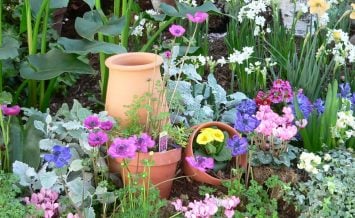Apples galore in your garden? Time to make chutney and jam
Experts offer advice on the best apples to grow for particular dishes, and how to preserve your bumper harvest.
Fed up with the thought of endless crumbles and pies? So, what else can you do with your bumper crops of apples?
It’s easy to make chutneys and jams from huge gluts, say experts from Arundel Castle (arundelcastle.org) in west Sussex, which has this year had an amazing harvest.
Senior organic kitchen gardener Izzy McKinley and artisan jam and chutney maker Christine Hart, owner of Sussex Jams And Chutneys, are helping to make the most of the season’s best.
Why bother preserving apples at home?

For much of the year, the apples on supermarket shelves are months old, says McKinley. Often imported, they are stored in warehouses with modified atmospheres that prevent them from ripening.
Preserving them in chutneys and jams during autumn is a more traditional way of enjoying British apples throughout the year.
While Pink Lady and Jazz apples are imported, your own apples may be just as suitable. Varieties you might grow yourself, such as ‘Egremont Russet’ and ‘Bramley’, can be transformed into delicious dishes.
Choosing your apples

‘Peasegood’s Nonsuch’ is a good all-rounder for preserving
McKinley and Hart agree that the best all-rounder is the ‘Peasegood’s Nonsuch’, a large apple from Lincolnshire. It is a cooking apple but requires much less sugar than other cookers, says Hart.
She says: “Never be put off by cooking apples, they are excellent to work with. It’s quicker to peel and prepare a large apple, and these varieties have a wonderfully sharp flavour. You can add sugar as you like. Cooking apples still produce deliciously sweet jams.
“While chutneys and apple sauce are popular choices, I like to make apple jams and serve with scones, as an autumnal alternative to a classic cream tea.”
Other ways of preserving apples this autumn include…
Chutney

Making chutney is like making jam, except it will have a longer cooking time and include vinegar, less sugar and more savoury ingredients, such as onions. Unleash your creativity and experiment with adding spices, fruits or even seasonal vegetables, such as squash. Curry lovers can try making their own apple and mango chutney, the experts suggest.
No-cook relish
Make your own apple relish without having to cook. Combine apples, vinegar, sugar and seasoning, then store in the fridge for two to three days, shaking each day. It’ll keep for up to one week. As with all preserves, it’s vital to sterilise the jars properly first.
Drying

Dried apples can be eaten as a sweet snack
Thinly sliced apples should be dipped in an acidic solution (such as lemon juice and water) to prevent browning, then dried in an oven at a low temperature or in a food dehydrator. Both methods take up to 12 hours. The apples can be stored in a Ziplock bag and, if optimally dried and stored, will last up to six months. Eat them as a sweet snack or crumbled on granola.
Juicing
While freshly home-made apple juice will only keep for two to three days in the fridge, it will last for a few months stored in plastic bags in the freezer, so it’s worth making plenty of your own, says McKinley.
Frozen apple juice has a range of culinary uses – use it as cooking liquid for gammon or serve over the festive season in spiced cocktails and mocktails.

Her top pick for juicing is the lesser-known variety ‘Ingrid Marie’. “It has a lightly aromatic juice and is a cross between ‘Cox’s Orange Pippin’ and ‘Elstar’,” she says.
Apple juice aficionados should also keep a lookout for the ‘Jupiter’, another ‘Cox’s Orange Pippin’ cross, which bursts with sweet juice, she suggests.
“For the ultimate home-made apple juice, our head gardener’s secret is to add one or two pears. The sweetness and texture that a ripe pear brings to an apple juice is unparalleled,” she says.
Hart’s easy seasonal apple and wild blackberry jam
(makes 4 jars – lasts up to a year)
Ingredients:
500g apples, ideally ‘Peasegood’s Nonsuch’ or ‘Bramley’, peeled, cored and diced
500g wild blackberries, or substitute for more apples
1kg sugar (adjusted according to the sweetness of your apples)
1-2 lemons, or 50ml of lemon juice
150ml water
Optional: Crème de Cassis (blackcurrant liqueur), brandy or ground cinnamon for an indulgent twist

Method:
1. You will need a jam thermometer, plus jam jars with lids
2. Before chopping, wash the fruit carefully. Add the chopped apples, wild blackberries and water into pan and gently simmer on a low heat for 15 minutes, to soften the fruit, stirring occasionally.
3. Add the sugar and stir until dissolved.
4. Add the 50ml of lemon juice.
5. Turn up the heat to medium/high for 10-15 minutes and bring the mixture to a rolling boil. Using a jam thermometer, wait until the temperature reaches 104.5 degrees and then test to see if setting point has been reached. At this point, you may add additional flavours, such as Crème de Cassis, brandy or cinnamon.
6. To test, place a small amount of preserve onto a heatproof dish that has been chilled in a fridge. Leave to stand for five minutes and run your finger through the mixture once it is cooled. It should wrinkle if set. Taste the preserve to see if it is at your desired sweetness.
7. Sterilise your jars and lids by washing in hot water, then place the jars in an oven at 120 degrees for 15 minutes. Place the lids in boiling water for five minutes, then remove and leave to dry in a warm oven.
8. Pour the preserve mixture into the hot, dry jars and fill to almost the top, leaving a small gap, and immediately seal the lid tightly onto the jars. Finally, label and store your jars for up to one year.

Have an alternative cream tea with apple and blackberry jam
The Press Association
Latest posts by The Press Association (see all)
- Could brisk walking boost your heart? - April 16, 2025
- Best spring-to-summer plants to fill the colour gaps - April 15, 2025
- Catherine tells how ‘spiritual’ connection with nature gives her peace in busy world - April 15, 2025
- Why weeds are worth cultivating – and eating - April 14, 2025
- 5 top tips for cleaning your tech, from phones to laptops - April 14, 2025




















